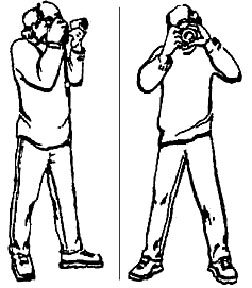Follow focus for DSLR video
Epigraph
“I twist-twist, I want to focus”
I am engaged in shooting and subsequent editing of the video. Most of the shooting is on professional and semi-professional cameras. But recently I had to indulge in shooting on a digital SLR. Without going into all the details and the problems that have arisen, I dedicate this post to our
The essence of the problem: when shooting video on DSLR when the mirror is raised (liveview mode), the camera automatics when focusing is not an assistant — only manual focusing. And if during photography it doesn’t cause any particular problems, then manual focus in video mode spoils a fair amount of nerve cells.
Under the cut a small study of existing solutions to the
When photographing, the photographer is approximately in this position (variations are possible depending on the width of the shoulders)
')

But when shooting a video, using the viewfinder will not work (deliberately not taking into account the new flagship from Sony with a translucent mirror, by the way it focuses quite well, but there are some problems in terms of choosing glass). Sighting occurs exclusively on the screen. (If possible, you can connect a small TV, which makes it easier to track the focus) If you are not adherent to fashioning constantly focus on Brownowski (which, according to my observations, is now an incredible amount) running around the frame, then there is a natural desire to control it. And not only when shooting with a tripod, but also from the
Naturally the first thing it was decided to just shoot as is. When shooting more or less static plans, without much of a dynamic in the frame, it came out pretty well, somewhere from 1–3 doubles. But when shooting in motion and when the focus shifted several times from plan to plan, problems started. Focus then flew over the desired plan or did not reach. Approximately the same way soapboxes focus in poor light. After futile attempts to pull in, we abandoned this idea - time was running out. In order to reassure his self-esteem, this Kosk was attributed to the imperfection of the vestibular apparatus and poor coordination of the operator. Those. focus in the frame moves back and forth, and the ring must be rotated left-right.
Further, it was suggested that we were not the first to ask about this problem. After all, before the advent of electronics somehow filmed a movie. As they say: the new is a well-studied old, even if it is a bicycle. This solution has long been used in the film industry and everything that could be invented has long been invented.

And voila. A simple system worth a lot of money for cameras (Ariflex produces and offers such things for N thousands of dollars). They also make similar systems for DSLRs, also with an exorbitant price tag of around 2k USD.

Here it is, it would seem, the finished version! But the price tag caused a spiritual contradiction, because the cost of this system was equal to the cost of our Canon 7D. For German quality and a long-term history of film equipment production embodied in several tubes, one small gearbox and a pair of cogs at least it would be sacrilegious to pay. In this opinion, we were supported by industrious and honest inhabitants of the Middle Kingdom. Without specifying specific sites, the price tag on Chinese auctions turned out to be very tasty in the region of 100-300 USD and still with free shipping (although the delivery time is around a month).

(Similar systems can also be found here, but they are still brought from China or from India, and sometimes the seller honestly indicates the monthly delivery time and even, actually, the manufacturer’s Chinese website).
But these terms did not suit. (By the way, the device was still ordered and should arrive sometime in February)
Through a global network, several DIY solutions were found. But most of them boiled down to one very simple formula (most of the authors are residents of the
But one video saved us from the fiasco, with a simple decision like a boot. Although it was not a panacea, it made the filming process much easier.
Once again after the filming, I made sure that the video was video cameras, and the photos, respectively, were cameras. To use DSLR in video production, you need to invest well in additional devices. What eventually flies in a good penny. And then the price gap between DSLR and professional video cameras is not so big. Although, it all depends on what tasks to set and what goals to tag.
In any case, the cameras seriously increased the number of people who were passionate about video and embodying their wildest ideas in the
Source: https://habr.com/ru/post/135958/
All Articles